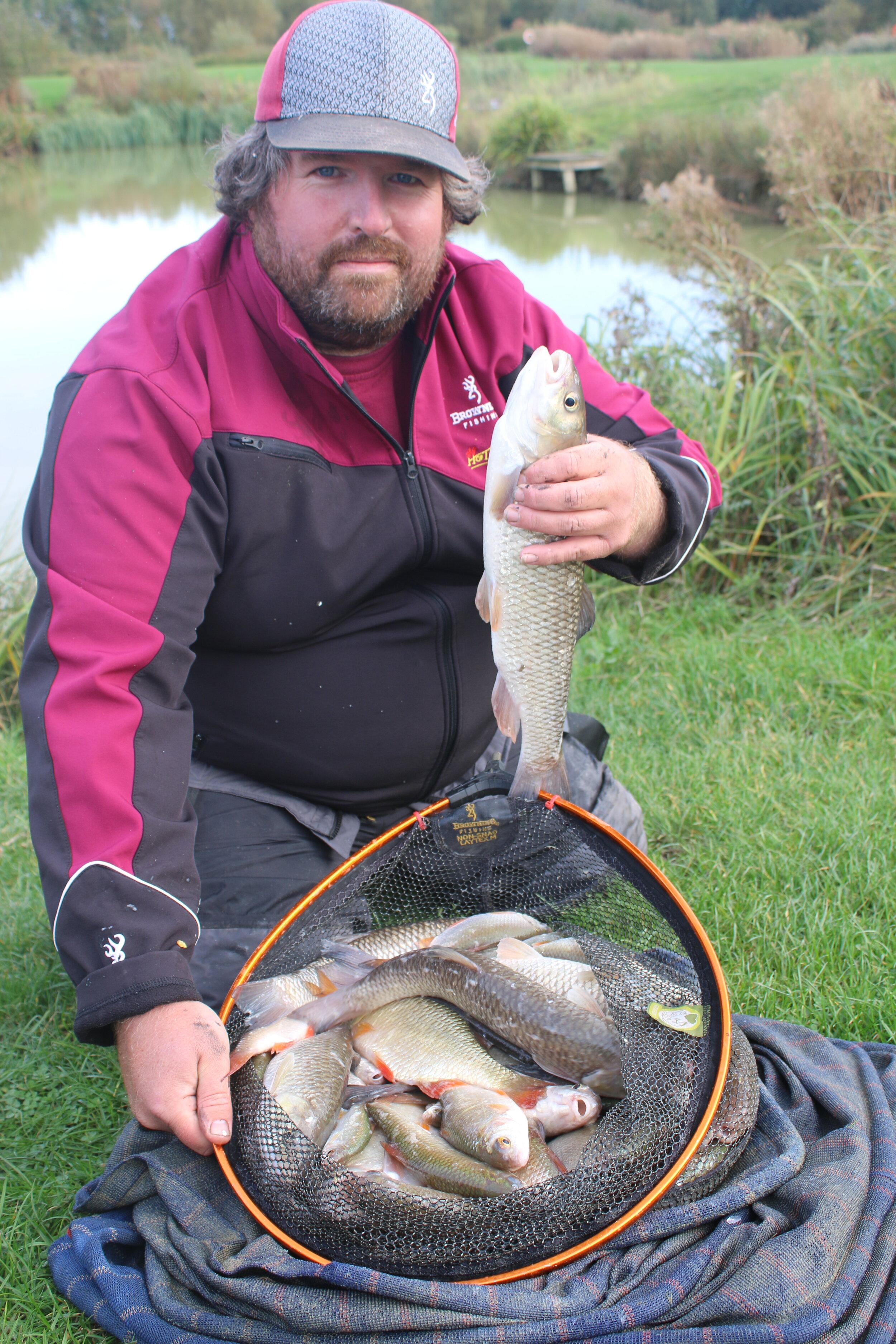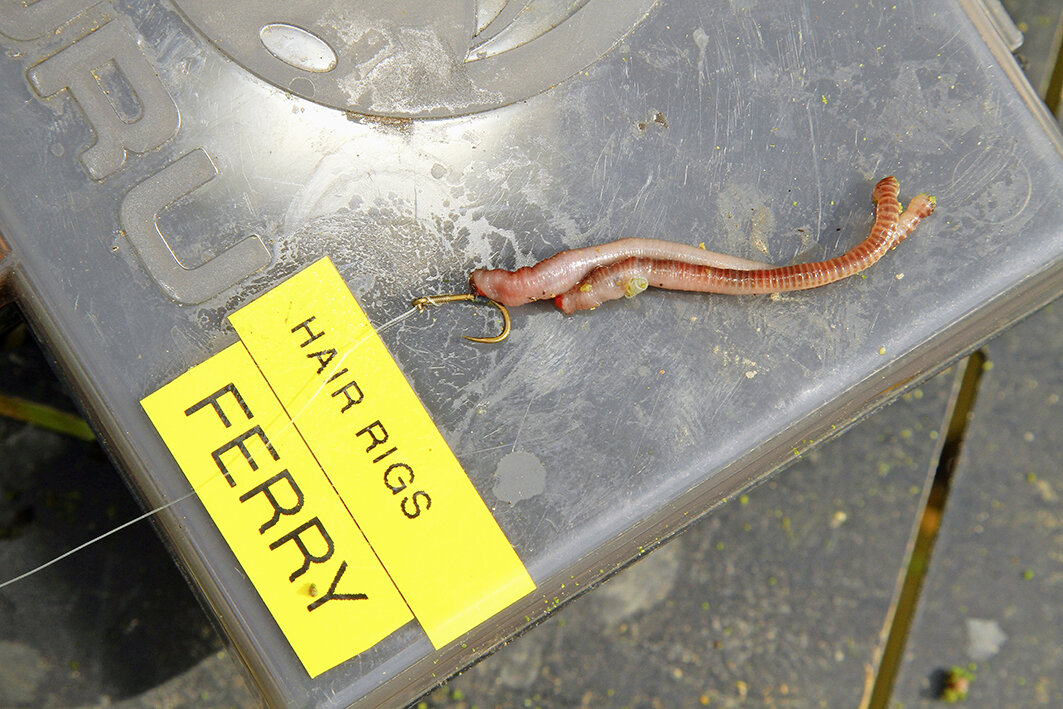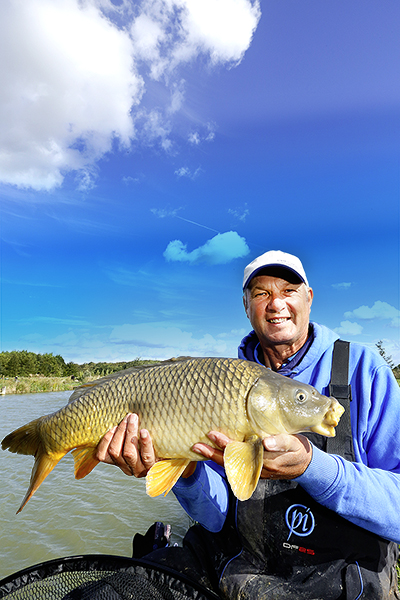Commercial Fishing Tips| Six steps to November success with Tommy Pickering
WATCH THE CLOCK
I always keep an eye on my watch but timings aren’t set in stone. I’ll want to catch on the feeder and long pole for the first half of a session then, with three hours to go, move to the 6m line and then the margins.
Start long and come short
FEEDER OR BOMB?
I’ll always begin on a small Hybrid feeder with micros cast to an island, to a distance where I can loosefeed pellets comfortably. If the feeder is slow I can then change to a bomb, and still feed the swim.
If the feeder is slow, switch to the bomb
DROP FEEDER SHORT
A Method feeder on the short pole line can be deadly when the lake is towing hard or if I’m getting liners from fish coming off the bottom. The rod you’ve used to cast to an island or open water will do nicely.
Don’t be afraid to drop the feeder short
ALWAYS USE A POT
Once I drop a rig in, I change from hand feeding to a small pole pot. This way I can line the fish up where I want them. Normally I’ll be feeding 4mm pellets, but micros also work if the peg is shallow.
Deliver feed with a pole pot
BRIGHT HOOKBAITS
If I’m not catching well, my first action is to change to a bright hookbait. Fjuka Neeonz are brilliant and I’ll use yellow or white for clearer water, pink or orange for coloured lakes.
Bright hookbaits will buy you extra bites
ACCURATE FEEDING
For accurate grouping, cup your hand with the feed almost on your fingertips. This way there’s no spread of bait – do it with a more open hand and it’ll go everywhere!
Accurate feeding is vital
Commercial Fishing Tips - How close should you fish to islands? - Tommy Pickering
How close you should fish to islands all depends on the fish.
Islands are a great holding feature for fish, but you don’t always have to fish tight to them
F1s like around 18ins of water and I normally catch them by casting just short of the island.
Carp prefer 12ins of depth and can be attacked by chucking tight. Late in the day the carp may well end up almost hugging the island, moving into the really shallow water.
To find this depth, cast out with a bomb and try to get a feel of things. You won’t have a count, as the water is too shallow, but if it’s a foot deep, the lead should hit bottom immediately. If it’s a bit deeper, it’ll take a fraction longer to settle.
Carp prefer 12ins of depth near islands
What is the right sized reel?
In the market for a new reel but get confused by all of the reel sizes available then make sure that you read this whole article as angling legend Tommy Pickering will be explaining what each fishing reel size does and what is best for your style of angling.
When it comes to purchasing a new float or feeder rod there is every chance you will spend hours scouring the internet looking at the pros and cons of various aspects of each product.
It is sensible to put tackle under scrutiny to see whether it is right for the job in hand, but why people never give their reel choice the same treatment is beyond me.
I see lots of anglers using reels that are completely unsuited to the type of fishing they are doing. I’m going to look at the three key reel sizes and explain when they should come into play.
REEL SIZES
3000 size – This size reel is ideal when fishing small commercials where a short cast is all that is required. A small 3000 reel won’t help you cast long distances but is perfect for chucks of 30m or less. I will use this when fishing tactics such as the waggler, and will have a maximum of 5lb mainline on the spool.
4000 size – If you need to chuck up to 40m when using a tactic such as the Method or groundbait feeder then step up to a 4000 size reel. When you are reeling in feeders or floats from any distance you need a reel that has a little more power to retrieve them quickly, and this does just that. As a simple rule of thumb I will use 6lb or 8lb mainline on the spool.
5000 size – When a long chuck is required a big reel must be used to hit the distance, and a 5000 size usually comes into play when I am after bream at range on the feeder. For this type of fishing I will use 5lb mainline with an 8lb shockleader that is double the length of the rod to stop me cracking off on the cast. If I used heavier mainline on the spool I would not be able to cast the required distance, as thicker diameter line hinders big chucks.
Are you sitting comfortably?
You arrive at your chosen peg and the excitement of bagging up soon takes over. The kit is hauled out of the car, the box is placed on the platform, and it’s then on to getting the pole and rods ready for a busy session.
Positioning your box properly could make all the difference between getting a fish-a-chuck in comfort or waking up the morning after racked with aches and pains. So this week I show you how to correctly set your seat box up...
If your seatbox is too low and tilting back slightly you’ll have to tuck your knees in and you’ll become uncomfortable in no time at all. Shipping back your pole will be really tricky if you are in this position, and there is no doubt that it will lead to you missing bites and losing fish.
Sitting too high is also a recipe for disaster and will mean you have to extend your legs a lot more to have your feet flat on your footplate. This will result in you holding your pole at an awkward angle which will again lead to you putting fewer fish in your net. Over-extending for hours on end will also lead to a lot of aches and pains once the session is over.
The height at which you set your seatbox has a big impact on your balance and comfort. A 90-degree bend from your knee to the footplate will allow you to lay the pole across your knees and keep your back straight. Pole fishing can be tiresome at times, especially at longer lengths, so having your seatbox properly positioned will help no end.
Tommy Pickering's greatest tips revealed!
When it comes to boosting your catches in early-spring, there’s no one more qualified to help than Tommy Pickering. The former world champion andcurrent Preston Innovations England feeder team boss is one of the world’s best all-round anglers, and this week he reveals a boxful of tips that will bring more fish your net.
Bait
LIght Groundbait
A light-coloured groundbait mix will always outscore a darker version when roach are the main target. The species tends to feed more confidently over a light blend, and a very fine product that has minimal feed content should be used to prevent overfeeding the shoal. Sonubaits Super Crumb Lake ticks all the boxes.
Pinkies for big fish
Worms, casters and maggots may seem like three deadly baits for skimmers, but pinkies go top of my list when fishing for the species on natural venues. Mix plenty of them into your groundbait, use two or three on the hook and you’ll find you are picking out much bigger stamp fish than other anglers around you.
Try a binding agent
If you are struggling to get your pellets to cling to the Method feeder then add a binding agent. Dampen your 2mm pellets as usual and then add one spoonful of Sonubaits Stiki Pellet to a pint of bait. This will make sure the pellets stick when casting and as the feeder falls, but also ensure they start to break down slowly once the feeder hits the deck.
Which goes first?
Add groundbait to the water when making paste but add water to the groundbait when making groundbait. This subtle change is may seem unimportant but it is essential, and will make sure your bait takes on the consistency that you require for the job
How to hook casters
There are two different ways to hook a caster, and how the day is going will dictate the best way to do it. The first is to bury as much of the hook inside the shell as possible. This produces more action when silvers are cagey. When they drop their guard, have the hookpoint fully exposed so you reduce the number of missed bites
Vary your pellets
Pellets are the staple diet of most commercial fish but the fish can wise up to them at times. In order to give yourself an edge, feed standard coarse pellets but use a flavoured or coloured pellet over the top to fool bites from wary specimens.
Cylinders V Cubes
Punched cylinders of meat are stacks better than cubes when fishing on the feeder. This is because the shape of cubed meat leads to twists occurring in the hooklength when you reel in.
Try pop-up boilies
The bomb and popped-up bread can be fantastic for carp and F1s on commercials right now but don’t neglect boilies. An 8mm or 10mm pop-up can be a better option if you are getting lots of little plucks that you can’t hit – small silverfish are often the culprits. Pop-ups are also better when you are waiting long periods, as you can be a lot more confident that the hookbait is still on the hair and hasn’t disintegrated.
Floats
Which float stem
The type of stem that your stick float has should be dictated by the conditions you are fishing in. Cane is best when trying to catch silvers on the drop, alloy versions are more stable in unpredictable, boiling swims and plastic-stemmed floats stand upright as soon as they hit the water. They are therefore real winners in turbulent and pacey swims.
Quick Change Swivel
Always use a snap link swivel with any kind of waggler. This will enable you to quickly change the size or pattern of the float at any stage of the day.
Overcast and windback
Sink the line when using the waggler so that the float stays in the same place for longer. In order to achieve this, cast five yards beyond your target zone, before winding the float back to your spot with the rod tip underwater. A small amount of line may still be floating and this can be sunk by sharply flicking the rod tip upwards.
Dot it right down
Never have any more than half the float bristle showing when pole fishing. When fishing for shy-biting species such as F1s, dot it down so only a few millimetres are showing. This can be done by adding tiny shot such as No12 Stotz to your rig in order to fine-tune it.
Accuracy every time and how to keep a short line
Pick a far-bank marker in order to fish in exactly the same spot all day. Line your swim up with an object that won’t move and make sure you are facing it when the rig goes in. Place your elbow on the same spot to get the same distance every time.
If you want to hit every carp and F1 bite on commercials you must keep a short line between pole-tip and float. Use a 6ins length in still conditions, 9ins if there is a ripple, and a foot if it is a bit windy.
Tackle
How long a rod?
Too many people don’t pay attention to the length of feeder rod they are using, but your choice will dictate how accurate your casting is. For fishing 30 yards out on a standard commercial, opt for a 10ft version, stepping up to a 12ft or 13ft rod when chucking beyond 50 yards on bigger waters.
Make yourself comfortable
Being comfortable when fishing from a box is incredibly important, or your mind will soon drift off the job. Make sure your side tray is as high as it can be so that you can reach bait with ease. Rig roosts and keepnets should also be easily accessible without having to over extend.
Positioning a pot
The positioning of your pole pot on the top kit will dictate how successful you are. Make sure it is only a few inches from the pole so that any loosefeed you drop in goes directly over the top of your hookbait.
Fail-safe shotting
Shotting patterns are rarely given the attention they deserve, and if you are after a mixed bag on commercials then one patterns always works well. Place a bulk of shot around 18ins to 2ft away from the hook and have three smaller dropper shot spread evenly between that and the hooklength loop. This will slow the fall of your hookbait and make it look natural as it nears the bottom.
Keep a short hair
The difference between an effective hair rig and one that doesn’t lead to many fish in the net is literally a few millimetres. The shorter the hair rig, the better and I find that hair rigs where there is only a tiny gap between the bait and the hook are most effective.
Control your area
On a busy commercial, think carefully about where you are going to fish. If all the anglers opposite are casting to the middle then the fish will probably avoid this commotion and go elsewhere. Look to fish in your own patch of water – even if that means coming shorter – and you’ll find more feeding fish.
Try a heavy plummet
We all know that plumbing the depth is important, but using the correct plummet is a must. If it is too light, you won’t be able to work out the contours of the bottom whereas a 20g-30g version will give you the precision that is required when using the pole.
Sensibly strong rigs
If a fishery states that the carp run up to 15lb, don’t set up a rig to catch only fish of that size. Using heavy lines and hooks you’ll miss out on bites from smaller fish, so compromise.
Feeder
longer hooklengths
On rivers I find an 18ins to 2ft hooklength best in coloured water. When bream fishing in normal conditions I will step up to 3ft, and 5ft for barbel, as they tend to sit well away from the feeder on big rivers like the Trent.
Don’t move a feeder
Once you have cast a feeder out don’t move it out of place. With a Method or pellet feeder you will only empty the frame and move your hookbait out of the pile of freebies. This will ultimately make the whole rig ineffective. When you cast out, make sure the feeder hits the water with the mainline still slack, so you can put a bend in the tip without moving the feeder.
Give it a chance
If your feeder is in the right place, leave it in the water for a long period of time. At this time of year you may only be fishing for 10 fish so don’t be afraid of leaving it be for up to 20 minutes.
Why plastic is best
I prefer a plastic open-end feeder to wire. This is because I am much more confident that all the bait stays in it until it gets to the bottom, and it also retrieves easier and doesn’t vibrate as much in the water.
Depth-Finder
To find the depth on bomb or feeder cast out a 1oz bomb. Once it hits the water start counting. A bomb of this size falls at a rate of a foot every half second, so you can work it out from there.
Fishing a light bomb
When fishing the bomb, the lightest lead you can get away with should be used at this time of year. Any excess commotion will spook any fish you have landed on and when fishing on commercials, a 3/8oz to ½oz bomb is about right.
Match feed to venue
Feeder groundbait when targeting bream depends on the water I am on. If it is a commercial that sees a lot of pellets than I will use a fishmeal-based product such as Sonubaits Bream Feeder, but if I am on a natural water I’ll turn to a cereal recipe such as Sonubaits Super Crumb Bream.
Half- Filled feeder
Half-filling a Banjo feeder is a fantastic way of getting extra bites in the cold. The reduced amount of food around the feeder forces the fish into taking the hookbait and it is often the bigger specimens that fall for this trick.

































